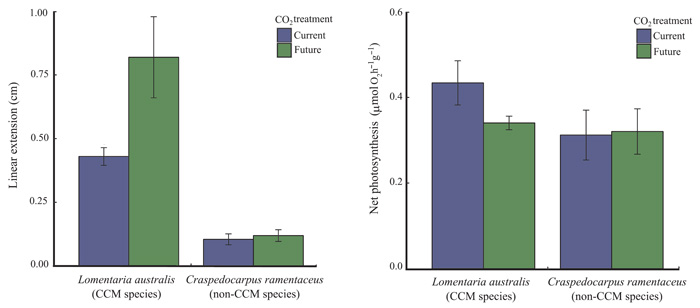| Tweet | Follow @co2science |
Paper Reviewed
van der Loos, L.M., Schmid, M., Leal, P.P., McGraw, C.M., Britton, D., Revill, A.T., Virtue, P., Nichols, P.D. and Hurd, C.L. 2019. Responses of macroalgae to CO2 enrichment cannot be inferred solely from their inorganic carbon uptake strategy. Ecology and Evolution 9: 125-140.
Macroalgae are considered foundation species, providing food, shelter and habitat to higher trophic levels in marine ecosystems. Yet, despite their ecological importance, van der Loos et al. (2019) state that "we know very little about their mechanistic physiological responses to future CO2 enrichment." Thus, it was the objective of this team of nine researchers to "compare the effects of CO2 enrichment on the growth, physiological, and biochemical responses of two temperate red macroalgae." The selected species included Craspedocarpus ramentaceus and Lomentaria australis, both of which inhabit the subtidal waters of eastern Tasmania, Australia.
Specimens of the two macroalgae were collected from the ocean waters near Tinderbox, Tasmania, and transported to the laboratory for culture in one of two CO2 treatments: ambient (pCO2 = 365 µatm, pH = 8.0) or elevated (pCO2 = 1015 µatm, pH = 7.7). At the end of a seven-day treatment period the authors collected a series of measurements to determine the biological response of the two red macroalgae to CO2 enrichment.
Results indicated that neither species was adversely impacted by ocean acidification (i.e., the elevated CO2 treatment). More specifically, as shown in the figure below, C. ramentaceus exhibited no change in net photosynthesis or linear extension, whereas L. australis experienced increased values for these two parameters under elevated CO2.
In commenting on their findings, van der Loos et al. conclude that the two-fold increase in growth rate by L. australis was "likely driven by a downregulation of the energetically costly carbon dioxide-concentrating mechanism" (CCM) operated by this species, which freed up more energy to be directed toward growth. The lack of response in C. ramentaceus, on the other hand, they say could be partly due to the fact that this species does not have a CCM and that the photosynthesis and growth of this species may be "saturated at current CO2 levels."
Regardless of the mechanisms responsible for the enhancement -- or lack thereof -- of these two macroalgae species to elevated CO2, ocean acidification surely did not have a negative impact, and ocean acidification alarmists should take note!

Figure 1. Linear extension (left panel) and net photosynthesis rates (right panel) of Lomentaria australis and Craspedocarpus ramentaceus in ambient (pH = 8.0) and elevated (pH = 7.7) CO2 treatments. Source: van der Loos et al. (2019).




